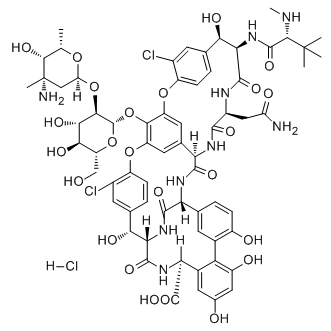
Vancomycin hydrochloride
CAS No. 1404-93-9
Vancomycin hydrochloride( Lyphocin )
Catalog No. M11696 CAS No. 1404-93-9
An antibiotic used to treat a number of bacterial infections that acts by inhibiting proper cell wall synthesis.
Purity : >98% (HPLC)
 COA
COA
 Datasheet
Datasheet
 HNMR
HNMR
 HPLC
HPLC
 MSDS
MSDS
 Handing Instructions
Handing Instructions
| Size | Price / USD | Stock | Quantity |
| 1G | 49 | In Stock |


|
Biological Information
-
Product NameVancomycin hydrochloride
-
NoteResearch use only, not for human use.
-
Brief DescriptionAn antibiotic used to treat a number of bacterial infections that acts by inhibiting proper cell wall synthesis.
-
DescriptionAn antibiotic used to treat a number of bacterial infections that acts by inhibiting proper cell wall synthesis.Bacterial Infection Approved(In Vitro):Vancomycin is a large glycopeptide compound with a molecular weight of 1450 Da. Vancomycin is a unique glycopeptide structurally unrelated to any currently available antibiotic. It also has a unique mode of action inhibiting the second stage of cell wall synthesis of susceptible bacteria. Vancomycin is active against a large number of species of Gram-positive bacteria, such as Staphylococcus aureus, Staph. epidermidis, Str. agalactiae, Str. bovis, Str. mutans, viridans streptococci, enterococci.(In Vivo):Vancomycin is administered intravenously, with a standard infusion time of at least 1 h, to minimize infusion-related adverse effects. Subjects with normal creatinine clearance, vancomycin has an α-distribution phase of 30 min to 1 h and a β-elimination half-life of 6-12 h. The volume of distribution is 0.4–1 L/kg. The binding of vancomycin to protein ranges from 10% to 50%. Factors that affect the overall activity of vancomycin include its tissue distribution, inoculum size, and protein-binding effects. Vancomycin treatment of infected mice is associated with improved clinical, diarrhea, and histopathology scores and survival during treatment.
-
In VitroVancomycin is a large glycopeptide compound with a molecular weight of 1450 Da. Vancomycin is a unique glycopeptide structurally unrelated to any currently available antibiotic. It also has a unique mode of action inhibiting the second stage of cell wall synthesis of susceptible bacteria. Vancomycin is active against a large number of species of Gram-positive bacteria, such as Staphylococcus aureus, Staph. epidermidis, Str. agalactiae, Str. bovis, Str. mutans, viridans streptococci, enterococci.
-
In VivoVancomycin is administered intravenously, with a standard infusion time of at least 1 h, to minimize infusion-related adverse effects. Subjects with normal creatinine clearance, vancomycin has an α-distribution phase of 30 min to 1 h and a β-elimination half-life of 6-12 h. The volume of distribution is 0.4–1 L/kg. The binding of vancomycin to protein ranges from 10% to 50%. Factors that affect the overall activity of vancomycin include its tissue distribution, inoculum size, and protein-binding effects. Vancomycin treatment of infected mice is associated with improved clinical, diarrhea, and histopathology scores and survival during treatment.
-
SynonymsLyphocin
-
PathwayGPCR/G Protein
-
TargetAntibacterial
-
Recptorcellwall
-
Research AreaInfection
-
IndicationBacterial Infection
Chemical Information
-
CAS Number1404-93-9
-
Formula Weight1485.715
-
Molecular FormulaC66H76Cl3N9O24
-
Purity>98% (HPLC)
-
SolubilityDMSO: 24 mg/mL
-
SMILESC[C@H]1[C@H]([C@@](C[C@@H](O1)O[C@@H]2[C@H]([C@@H]([C@H](O[C@H]2OC3=C4C=C5C=C3OC6=C(C=C(C=C6)[C@H]([C@H](C(=O)N[C@H](C(=O)N[C@H]5C(=O)N[C@@H]7C8=CC(=C(C=C8)O)C9=C(C=C(C=C9[C@H](NC(=O)[C@H]([C@@H](C1=CC(=C(O4)C=C1)Cl)O)NC7=O)C(=O)O)O)O)CC(=O)N)NC(=O)[C@@H](CC(C)C)NC)O)Cl)CO)O)O)(C)N)O.Cl
-
Chemical NameVancomycin, hydrochloride
Shipping & Storage Information
-
Storage(-20℃)
-
ShippingWith Ice Pack
-
Stability≥ 2 years
Reference
molnova catalog



related products
-
N-Butanoyl-L-homoser...
N-Butanoyl-L-homoserine lactone is a cleavable ADC linker used in the synthesis of antibody-drug conjugates (ADCs).
-
Quorum Sensing-IN-3
Quorum Sensing-IN-3 (QS-IN-1) is a compound with inhibitory effects on bacterial community sensing, which inhibits the exchange of information between bacteria and inhibits biofilm formation.
-
Genz 669178
A potent PfDHODH inhibitor that exhibits low nanomolar in vitro potency against DHODH from P falciparum, P vivax, and P berghei.



 Cart
Cart
 sales@molnova.com
sales@molnova.com


